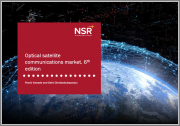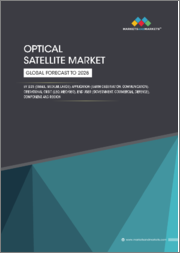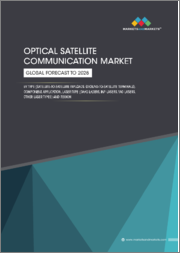
|
시장보고서
상품코드
1279821
세계의 광 위성통신 시장 규모 조사 및 예측 : 컴포넌트별, 용도별, 지역별 분석(2022-2029년)Global Optical Satellite Communication Market Size study & Forecast, by Component by Application and Regional Analysis, 2022-2029 |
||||||
세계의 광 위성통신 시장은 2021년 약 75억 2,000만 달러로 평가되며, 2022-2029년의 예측 기간 중 21.30% 이상의 건전한 성장률로 성장할 것으로 예상됩니다.
자유공간광통신(FSOC)으로도 알려진 광 위성통신은 레이저 빔을 사용하여 우주공간을 통해 정보를 전송하는 통신방식으로, 일반적으로 위성 간 또는 위성에서 지상의 수신기까지 전송하는 통신방식입니다. 이 기술은 높은 대역폭, 좁은 빔 발산, 낮은 간섭과 같은 빛의 특성을 이용하여 우주 공간에서 고속 및 대용량 데이터 전송을 가능하게 합니다. 광 위성통신 시장은 멀티미디어 서비스 수요 증가, 휴대폰 사용자 증가 등의 요인으로 인해 확대되고 있습니다.
광 위성통신은 전파, 마이크로파 등 기존 무선 주파수(RF) 통신 방식에 비해 몇 가지 장점이 있습니다. 지난 수십년 동안 그 중요성이 점차 증가하고 있으며, Statista에 따르면 2021년 미디어 엔터테인먼트 사업 가치는 2조 3,400억 달러에 달하고 2026년 말에는 2조 9,300억 달러에 달할 것으로 예상됩니다. 또한 2022년 미국에서 실시된 '가장 많이 이용하는 미디어 서비스'에 대한 조사에서 응답자의 87%가 디지털 비디오 컨텐츠를 꼽았다고 합니다. 공간 증가를 촉진하는 또 다른 중요한 요소는 휴대폰 사용자 수로, Statista에 따르면 세계 스마트폰 모바일 네트워크 계약 건수는 2022년 66억 건 이상에 달하고 2028년에는 78억 건을 넘어설 것으로 예상합니다. 또한 가장 많은 스마트폰 모바일 네트워크 가입자를 보유한 국가는 중국, 인도, 미국으로 나타났습니다. 또한 2021년에는 미국이 세계 인구의 82.2%를 차지해 스마트폰 보급률이 가장 높을 것으로 예상됩니다. 또한 우주 임무에 대한 지출 증가와 광 위성통신의 기술 발전은 예측 기간 중 이 시장에 유리한 성장 전망을 가져다 줄 것입니다. 그러나 광 위성통신의 고비용은 2022-2029년의 예측 기간 중 시장 성장을 저해할 것입니다.
세계의 광 위성통신 시장 조사에서 고려된 주요 지역은 아시아태평양, 북미, 유럽, 중남미 및 기타 지역입니다. 북미는 통신 부문의 성장과 첨단 기술의 높은 도입으로 수익 측면에서 시장을 지배하고 있으며, Statista에 따르면 2022년 4월 미국은 지구 궤도에 있는 5,465개의 활성 위성 중 약 3,433개의 운영 위성을 보유하고 있습니다. 또한 아시아태평양은 휴대폰 보급과 디지털 위성 방송 증가로 인해 예측 기간 중 가장 높은 CAGR로 성장할 것으로 예상됩니다.
이 연구의 목적은 최근 수년간 다양한 부문과 국가 시장 규모를 파악하고 향후 수년간 시장 규모를 예측하는 것입니다. 이 보고서는 조사 대상 국가의 산업의 질적, 양적 측면을 모두 포함하도록 설계되었습니다.
또한 시장의 미래 성장을 규정하는 촉진요인과 과제와 같은 중요한 측면에 대한 자세한 정보도 제공합니다. 또한 주요 기업의 경쟁 구도와 제품 제공에 대한 상세한 분석과 함께 이해관계자가 투자할 수 있는 미시적 시장에서의 잠재적 기회도 포함됩니다.
목차
제1장 주요 요약
- 시장 스냅숏
- 세계 시장·부문별 시장 추산·예측, 2019-2029년
- 광 위성통신 시장 : 지역별, 2019-2029년
- 광 위성통신 시장 : 컴포넌트별, 2019-2029년
- 광 위성통신 시장 : 용도별, 2019-2029년
- 주요 동향
- 조사 방법
- 조사의 전제조건
제2장 세계의 광 위성통신 시장 정의와 범위
- 조사의 목적
- 시장의 정의와 범위
- 조사 대상 범위
- 산업의 진화
- 조사 대상년
- 통화 환산율
제3장 세계 시장 역학
- 광 위성통신 시장 영향 분석(2019-2029년)
- 시장 촉진요인
- 멀티미디어 서비스에 대한 수요의 증가
- 휴대폰 사용자 수의 증가
- 시장이 해결해야 할 과제
- 광 위성통신의 고비용
- 시장 기회
- 우주 미션에 대한 투자 확대
- 광 위성통신에서 기술 진보의 증가
- 시장 촉진요인
제4장 세계의 광 위성통신 시장 산업 분석
- Porter's 5 Force 모델
- 공급 기업의 교섭력
- 구매자의 교섭력
- 신규 진출업체의 위협
- 대체품의 위협
- 경쟁 기업간 경쟁 관계
- Porter's 5 Force 모델의 미래적 어프로치(2019-2029년)
- PEST 분석
- 정치적
- 경제적
- 사회적
- 기술적
- 주요 투자 기회
- 주요 성공 전략
- 업계 전문가별 전망
- 애널리스트의 결론·제안
제5장 리스크 평가 : COVID-19의 영향
- COVID-19가 업계에 미치는 전체적인 영향에 관한 평가
- COVID-19 이전과 COVID-19 이후 시장 시나리오
제6장 세계의 광 위성통신 시장, 컴포넌트별
- 시장 스냅숏
- 세계의 광 위성통신 시장 : 컴포넌트별 실적·잠재력 분석
- 세계의 광 위성통신 시장, 컴포넌트별 추정·예측 2019-2029
- 광 위성통신 시장, 하위 부문별 분석
- 트랜스미터
- 리시버
- 기타
제7장 세계의 광 위성통신 시장 : 용도별
- 시장 스냅숏
- 세계의 광 위성통신 시장 : 용도별 실적 - 잠재력 분석
- 세계의 광 위성통신 시장, 용도별 추정·예측 2019-2029
- 세계의 광 위성통신 시장, 하위 부문별 분석
- 통신 분야
- 감시·보안
- 지구 관측
- 추적·감시
- 조사·우주 탐사
- 기타
제8장 세계의 광 위성통신 시장 : 지역별 분석
- 광 위성통신 시장 : 지역별 시장 스냅숏
- 북미
- 미국
- 컴포넌트별 추정·예측, 2019-2029년
- 용도별 추정·예측, 2019-2029년
- 캐나다
- 미국
- 유럽 광 위성통신 시장 스냅숏
- 영국
- 독일
- 프랑스
- 스페인
- 이탈리아
- 기타 유럽
- 아시아태평양의 광 위성통신 시장 스냅숏
- 중국
- 인도
- 일본
- 호주
- 한국
- 기타 아시아태평양
- 라틴아메리카의 광 위성통신 시장 스냅숏
- 브라질
- 멕시코
- 기타 라틴아메리카 지역
- 세계의 기타 지역
제9장 경쟁 정보
- 주요 시장 전략
- 기업 개요
- Analytical Space, Inc.(US)
- 주요 정보
- 개요
- 재무(데이터 입수가 가능한 경우만)
- 제품 개요
- 최근 동향
- ATLAS Space Operations, Inc.(US),
- National Aeronautics and Space Administration(US),
- BridgeSat Inc.(US),
- Maxar Technologies(US),
- Mitsubishi Electric Corporation(Japan),
- SITAEL S.p.A.(Japan),
- Ball Aerospace & Technologies(US),
- Laser Light Communications(US)
- Hisdesat Servicios Estrategicos, S.A.
- Analytical Space, Inc.(US)
제10장 조사 프로세스
- 조사 프로세스
- 데이터 마이닝
- 분석
- 시장 추정
- 밸리데이션
- 출판
- 조사의 특징
- 조사의 전제조건
Global Optical Satellite Communication Market is valued at approximately USD 7.52 billion in 2021 and is anticipated to grow with a healthy growth rate of more than 21.30% over the forecast period 2022-2029. Optical satellite communication, also known as free-space optical communication (FSOC), is a method of communication that uses laser beams to transmit information through space, typically between satellites or from satellites to ground-based receivers. This technology leverages the properties of light, such as its high bandwidth, narrow beam divergence, and low interference, to enable high-speed and high-capacity data transmission in space. The Optical Satellite Communication market is expanding because of factors such as a rise in demand for multimedia services and increase in number of Mobile Phone Users.
Optical satellite communication offers several advantages over traditional radio frequency (RF) communication methods, such as radio waves and microwaves. Its importance has progressively increased during the last few decades. According to the Statista, in 2021, the value of the media and entertainment business reached USD 2.34 trillion and expected to reach USD 2.93 trillion by the end of 2026. Furthermore, in 2022, "Digital video content was selected by 87% of respondents in a survey conducted on "Most used media services" in the United States. Another important component driving space increase is the number of Mobile Phone Users. As per Statista, the global number of smartphone mobile network subscriptions reached over 6.6 billion in 2022 and is expected to exceed 7.8 billion by 2028. Furthermore, the countries holding the most smartphone mobile network subscriptions were China, India, and the United States. In addition, in 2021, the United States accounts most significant smartphone penetration rates with 82.2% population around the world. Also, increasing spending in space missions and rising technological advancement in Optical Satellite Communication would create a lucrative growth prospectus for the market over the forecast period. However, the high cost of Optical Satellite Communication stifles market growth throughout the forecast period of 2022-2029.
The key regions considered for the Global Optical Satellite Communication Market study include Asia Pacific, North America, Europe, Latin America, and Rest of the World. North America dominated the market in terms of revenue, owing to the growth in the telecommunication sector and high adoption of advanced technologies within the region. According to the Statista, in April 2022, the United States accounts for about 3,433 operational artificial satellites out of the 5,465 active artificial satellites around the Earth orbit. Furthermore, Asia Pacific is expected to grow with a highest CAGR during the forecast period, owing to factors such as in the usage of mobile phones and a rise in the number of digital satellite broadcasting in the market space.
Major market players included in this report are:
- Analytical Space, Inc. (US)
- ATLAS Space Operations, Inc. (US),
- National Aeronautics and Space Administration (US),
- BridgeSat Inc. (US),
- Maxar Technologies (US),
- Mitsubishi Electric Corporation (Japan),
- SITAEL S.p.A. (Japan),
- Ball Aerospace & Technologies (US),
- Laser Light Communications (US)
- Hisdesat Servicios Estrategicos, S.A.
Recent Developments in the Market:
- In June 2022, Mitsubishi Electric Corp launched an optical receiver prototype for laser communication terminals. The prototype is the very first to incorporate space optical communication utilizing laser beams as well as a capability to determine the location of incoming rays in the 1.5-m band, which is a general-purpose band utilized for terrestrial optical fiber communications.
Global Optical Satellite Communication Market Report Scope:
- Historical Data: 2019-2020-2021
- Base Year for Estimation: 2021
- Forecast period: 2022-2029
- Report Coverage: Revenue forecast, Company Ranking, Competitive Landscape, Growth factors, and Trends
- Segments Covered: Component, Application, Region
- Regional Scope: North America; Europe; Asia Pacific; Latin America; Rest of the World
- Customization Scope: Free report customization (equivalent up to 8 analyst's working hours) with purchase. Addition or alteration to country, regional & segment scope*
The objective of the study is to define market sizes of different segments & countries in recent years and to forecast the values to the coming years. The report is designed to incorporate both qualitative and quantitative aspects of the industry within countries involved in the study.
The report also caters detailed information about the crucial aspects such as driving factors & challenges which will define the future growth of the market. Additionally, it also incorporates potential opportunities in micro markets for stakeholders to invest along with the detailed analysis of competitive landscape and product offerings of key players. The detailed segments and sub-segment of the market are explained below.
By Component
- Transmitters
- Receivers
- Other
By Application
- Telecommunication
- Surveillance and Security,
- Earth Observation,
- Tracking and Monitoring,
- Research and Space Exploration
- Others
By Region:
- North America
- U.S.
- Canada
- Europe
- UK
- Germany
- France
- Spain
- Italy
- ROE
- Asia Pacific
- China
- India
- Japan
- Australia
- South Korea
- RoAPAC
- Latin America
- Brazil
- Mexico
- RoLA
- Rest of the World
Table of Contents
Chapter 1. Executive Summary
- 1.1. Market Snapshot
- 1.2. Global & Segmental Market Estimates & Forecasts, 2019-2029 (USD Billion)
- 1.2.1. Optical Satellite Communication Market, by Region, 2019-2029 (USD Billion)
- 1.2.2. Optical Satellite Communication Market, by Component, 2019-2029 (USD Billion)
- 1.2.3. Optical Satellite Communication Market, by Application, 2019-2029 (USD Billion)
- 1.3. Key Trends
- 1.4. Estimation Methodology
- 1.5. Research Assumption
Chapter 2. Global Optical Satellite Communication Market Definition and Scope
- 2.1. Objective of the Study
- 2.2. Market Definition & Scope
- 2.2.1. Scope of the Study
- 2.2.2. Industry Evolution
- 2.3. Years Considered for the Study
- 2.4. Currency Conversion Rates
Chapter 3. Global Market Dynamics
- 3.1. Optical Satellite Communication Market Impact Analysis (2019-2029)
- 3.1.1. Market Drivers
- 3.1.1.1. Rise in demand for multimedia services
- 3.1.1.2. Increase in number of Mobile Phone Users
- 3.1.2. Market Challenges
- 3.1.2.1. High Cost of Optical Satellite Communication
- 3.1.3. Market Opportunities
- 3.1.3.1. Increasing spending in space missions
- 3.1.3.2. Rising technological advancement in Optical Satellite Communication
- 3.1.1. Market Drivers
Chapter 4. Global Optical Satellite Communication Market Industry Analysis
- 4.1. Porter's 5 Force Model
- 4.1.1. Bargaining Power of Suppliers
- 4.1.2. Bargaining Power of Buyers
- 4.1.3. Threat of New Entrants
- 4.1.4. Threat of Substitutes
- 4.1.5. Competitive Rivalry
- 4.2. Futuristic Approach to Porter's 5 Force Model (2019-2029)
- 4.3. PEST Analysis
- 4.3.1. Political
- 4.3.2. Economical
- 4.3.3. Social
- 4.3.4. Technological
- 4.4. Top investment opportunity
- 4.5. Top winning strategies
- 4.6. Industry Experts Prospective
- 4.7. Analyst Recommendation & Conclusion
Chapter 5. Risk Assessment: COVID-19 Impact
- 5.1. Assessment of the overall impact of COVID-19 on the industry
- 5.2. Pre COVID-19 and post COVID-19 Market scenario
Chapter 6. Global Optical Satellite Communication Market, by Component
- 6.1. Market Snapshot
- 6.2. Global Optical Satellite Communication Market by Component, Performance - Potential Analysis
- 6.3. Global Optical Satellite Communication Market Estimates & Forecasts by Component 2019-2029 (USD Billion)
- 6.4. Optical Satellite Communication Market, Sub Segment Analysis
- 6.4.1. Transmitters
- 6.4.2. Receivers
- 6.4.3. Other
Chapter 7. Global Optical Satellite Communication Market, by Application
- 7.1. Market Snapshot
- 7.2. Global Optical Satellite Communication Market by Application, Performance - Potential Analysis
- 7.3. Global Optical Satellite Communication Market Estimates & Forecasts by Application 2019-2029 (USD Billion)
- 7.4. Optical Satellite Communication Market, Sub Segment Analysis
- 7.4.1. Telecommunication
- 7.4.2. Surveillance and Security
- 7.4.3. Earth Observation
- 7.4.4. Tracking and Monitoring
- 7.4.5. Research and Space Exploration
- 7.4.6. Others
Chapter 8. Global Optical Satellite Communication Market, Regional Analysis
- 8.1. Optical Satellite Communication Market, Regional Market Snapshot
- 8.2. North America Optical Satellite Communication Market
- 8.2.1. U.S. Optical Satellite Communication Market
- 8.2.1.1. Component breakdown estimates & forecasts, 2019-2029
- 8.2.1.2. Application breakdown estimates & forecasts, 2019-2029
- 8.2.2. Canada Optical Satellite Communication Market
- 8.2.1. U.S. Optical Satellite Communication Market
- 8.3. Europe Optical Satellite Communication Market Snapshot
- 8.3.1. U.K. Optical Satellite Communication Market
- 8.3.2. Germany Optical Satellite Communication Market
- 8.3.3. France Optical Satellite Communication Market
- 8.3.4. Spain Optical Satellite Communication Market
- 8.3.5. Italy Optical Satellite Communication Market
- 8.3.6. Rest of Europe Optical Satellite Communication Market
- 8.4. Asia-Pacific Optical Satellite Communication Market Snapshot
- 8.4.1. China Optical Satellite Communication Market
- 8.4.2. India Optical Satellite Communication Market
- 8.4.3. Japan Optical Satellite Communication Market
- 8.4.4. Australia Optical Satellite Communication Market
- 8.4.5. South Korea Optical Satellite Communication Market
- 8.4.6. Rest of Asia Pacific Optical Satellite Communication Market
- 8.5. Latin America Optical Satellite Communication Market Snapshot
- 8.5.1. Brazil Optical Satellite Communication Market
- 8.5.2. Mexico Optical Satellite Communication Market
- 8.5.3. Rest of Latin America Optical Satellite Communication Market
- 8.6. Rest of The World Optical Satellite Communication Market
Chapter 9. Competitive Intelligence
- 9.1. Top Market Strategies
- 9.2. Company Profiles
- 9.2.1. Analytical Space, Inc. (US)
- 9.2.1.1. Key Information
- 9.2.1.2. Overview
- 9.2.1.3. Financial (Subject to Data Availability)
- 9.2.1.4. Product Summary
- 9.2.1.5. Recent Developments
- 9.2.2. ATLAS Space Operations, Inc. (US),
- 9.2.3. National Aeronautics and Space Administration (US),
- 9.2.4. BridgeSat Inc. (US),
- 9.2.5. Maxar Technologies (US),
- 9.2.6. Mitsubishi Electric Corporation (Japan),
- 9.2.7. SITAEL S.p.A. (Japan),
- 9.2.8. Ball Aerospace & Technologies (US),
- 9.2.9. Laser Light Communications (US)
- 9.2.10. Hisdesat Servicios Estrategicos, S.A.
- 9.2.1. Analytical Space, Inc. (US)
Chapter 10. Research Process
- 10.1. Research Process
- 10.1.1. Data Mining
- 10.1.2. Analysis
- 10.1.3. Market Estimation
- 10.1.4. Validation
- 10.1.5. Publishing
- 10.2. Research Attributes
- 10.3. Research Assumption



















